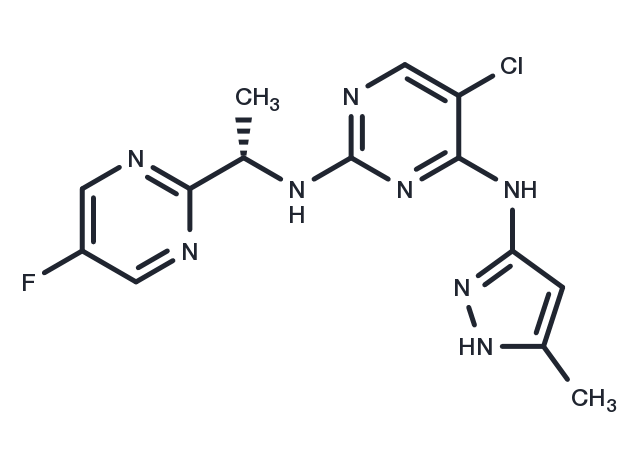Powder: -20°C for 3 years | In solvent: -80°C for 1 year
AZD1480 是 ATP 竞争型JAK1和JAK2抑制剂,IC50分别为 1.3 和 0.4 nM。

| 规格 | 价格/CNY | 货期 | 数量 | |
|---|---|---|---|---|
| 1 mg | ¥ 283 | 现货 | ||
| 5 mg | ¥ 661 | 现货 | ||
| 10 mg | ¥ 987 | 现货 | ||
| 25 mg | ¥ 1,830 | 现货 | ||
| 50 mg | ¥ 3,160 | 现货 | ||
| 100 mg | ¥ 4,660 | 现货 | ||
| 200 mg | ¥ 6,650 | 现货 | ||
| 1 mL * 10 mM (in DMSO) | ¥ 661 | 现货 | ||
| 产品描述 | AZD1480 is a novel ATP-competitive JAK2 inhibitor (IC50: 0.26 nM), selectivity act against Tyk2 and JAK3, and to a smaller extent against JAK1. AZD1480 has been used in trials studying the treatment of Solid Malignancies, Post-Polycythaemia Vera, Primary Myelofibrosis (PMF), and Essential Thrombocythaemia Myelofibrosis. |
| 靶点活性 | JAK2:0.26 nM |
| 体外活性 | AZD1480抑制皮下移植瘤的生长,并通过对STAT3活性的抑制使携带颅内恶性胶质瘤的鼠寿命延长,表明AZD1480对JAK/STAT3通路的抑制作用可用于研究治疗携带颅内恶性胶质瘤的患者.AZD1480可抑制人类实体瘤模型和多发性骨髓瘤模型的STAT3磷酸化.AZD1480可降低人类移植瘤模型的血管生成和代谢.AZD1480对含STAT活性的人类实体瘤的生长有抑制作用.AZD1480对骨髓细胞的肺转移和肺浸润瘤也有抑制作用. |
| 体内活性 | 通过影响肿瘤的微环境,AZD1480可抑制肿瘤局部转移和血管生成。作为JAK2的有效抑制剂,AZD1480可抑制人类多发性骨髓瘤细胞的生长和存活,并抑制FGFR3和STAT3信号及下游靶点,包括Cyclin D2。低微摩尔浓度AZD1480可诱导骨髓瘤细胞系凋亡和抑制细胞增殖。 AZD1480(5 μM)诱导细胞周期停在G2/M期,并通过抑制Aurora激酶而诱导细胞死亡。在人和鼠神经胶质瘤细胞中,AZD1480有效抑制组成型和诱导型JAK1/2及STAT-3的磷酸化作用 ,从而降低细胞增殖并诱导凋亡。 |
| 激酶实验 | kinase assays: Inhibition studies of AZD1480 are performed using recombinant Jak1, Jak2, or Jak3 under buffer conditions of 50 mM HEPES pH 7.3, 1 mM DTT, 0.01% Tween-20, 50 mM/ml BSA, and 10 mM MgCl2. Jak3 enzyme is expressed as N-terminal GST fusion in insect cells and purified by glutathione-affinity and size-exclusion chromatographies. Enzymes are assayed in the presence of AZD1480 (10 point dose response, in triplicate, from 8.3 μM to 0.3 nM in half-log dilution steps) using 1.5 μM peptide substrate (Jak1: FITC-C6-KKHTDDGYMPMSPGVA-NH2, Jak2 and Jak3: FAM-SRCtide) and screened under their respective ATP Km (Jak1: 55 μM, Jak2: 15 μM, Jak3: 3 μM) and approximated physiological ATP concentration of 5 mM. Phosphorylated and unphosphorylated peptides are separated and quantified by a Caliper LC3000 system for calculating percent inhibition. |
| 细胞实验 | Renca or 786-O cells are suspended in DMEM medium with 5% FBS , and seeded in 96-well plates (5×103 per well) to allow adhesion and then treated with DMSO or AZD1480 for 48 hours. Cell viability is determined by MTS assay. Absorbance at 490 nm is measured with Mikrotek Laborsysteme. Mouse endothelial cells and splenic CD11b+/c- myeloid cells are enriched from tumor-bearing mice,and cultured in 5% FBS RPMI-1640 medium. HUVECs are cultured on collagen 1–coated plates in complete medium. All cells are treated with DMSO and AZD1480 at various doses for 24 hours. Cell viability is determined by counting cell number manually. All the experiments are repeated 3 times. (Only for Reference) |
| 分子量 | 348.77 |
| 分子式 | C14H14ClFN8 |
| CAS No. | 935666-88-9 |
Powder: -20°C for 3 years | In solvent: -80°C for 1 year
Ethanol: < 1 mg/mL (insoluble or slightly soluble)
H2O: < 1 mg/mL (insoluble or slightly soluble)
DMSO: 64 mg/mL (183.5 mM)
| 可选溶剂 | 浓度 体积 质量 | 1 mg | 5 mg | 10 mg | 25 mg |
| DMSO | 1 mM | 2.8672 mL | 14.3361 mL | 28.6722 mL | 71.6805 mL |
| 5 mM | 0.5734 mL | 2.8672 mL | 5.7344 mL | 14.3361 mL | |
| 10 mM | 0.2867 mL | 1.4336 mL | 2.8672 mL | 7.168 mL | |
| 20 mM | 0.1434 mL | 0.7168 mL | 1.4336 mL | 3.584 mL | |
| 50 mM | 0.0573 mL | 0.2867 mL | 0.5734 mL | 1.4336 mL | |
| 100 mM | 0.0287 mL | 0.1434 mL | 0.2867 mL | 0.7168 mL |
对于不同动物的给药剂量换算,您也可以参考 更多...
请在以下方框中输入您的动物实验信息后点击计算,可以得到母液配置方法和体内配方的制备方法: 比如您的给药剂量是10 mg/kg,每只动物体重20 g,给药体积100 μL,一共给药动物10 只,您使用的配方为5% DMSO+30% PEG300+5% Tween 80+60% ddH2O。那么您的工作液浓度为2 mg/mL。
母液配置方法:2 mg 药物溶于 50 μL DMSO (母液浓度为 40 mg/mL), 如您需要配置的浓度超过该产品的溶解度,请先与我们联系。
体内配方的制备方法:取 50 μL DMSO 主液,加入 300 μL PEG300, 混匀澄清,再加 50 μL Tween 80,混匀澄清,再加 600 μL ddH2O, 混匀澄清。
您可能有的问题的答案可以在抑制剂处理说明中找到,包括如何准备库存溶液,如何存储产品,以及基于细胞的分析和动物实验需要特别注意的问题。
AZD-1480 935666-88-9 Angiogenesis Chromatin/Epigenetic JAK/STAT signaling Stem Cells JAK inhibit Inhibitor Janus kinase AZD1480 AZD 1480 inhibitor
